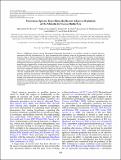| dc.contributor.author | Kozak, Krzysztof M. | en_US |
| dc.contributor.author | Wahlberg, Niklas | en_US |
| dc.contributor.author | Neild, Andrew F. E. | en_US |
| dc.contributor.author | Dasmahapatra, Kanchon K. | en_US |
| dc.contributor.author | Mallet, James | en_US |
| dc.contributor.author | Jiggins, Chris D. | en_US |
| dc.date.accessioned | 2015-05-04T15:26:46Z | |
| dc.date.issued | 2015 | en_US |
| dc.identifier.citation | Kozak, Krzysztof M., Niklas Wahlberg, Andrew F. E. Neild, Kanchon K. Dasmahapatra, James Mallet, and Chris D. Jiggins. 2015. “Multilocus Species Trees Show the Recent Adaptive Radiation of the Mimetic Heliconius Butterflies.” Systematic Biology 64 (3): 505-524. doi:10.1093/sysbio/syv007. http://dx.doi.org/10.1093/sysbio/syv007. | en |
| dc.identifier.issn | 1063-5157 | en |
| dc.identifier.uri | http://nrs.harvard.edu/urn-3:HUL.InstRepos:15034864 | |
| dc.description.abstract | Müllerian mimicry among Neotropical Heliconiini butterflies is an excellent example of natural selection, associated with the diversification of a large continental-scale radiation. Some of the processes driving the evolution of mimicry rings are likely to generate incongruent phylogenetic signals across the assemblage, and thus pose a challenge for systematics. We use a data set of 22 mitochondrial and nuclear markers from 92% of species in the tribe, obtained by Sanger sequencing and de novo assembly of short read data, to re-examine the phylogeny of Heliconiini with both supermatrix and multispecies coalescent approaches, characterize the patterns of conflicting signal, and compare the performance of various methodological approaches to reflect the heterogeneity across the data. Despite the large extent of reticulate signal and strong conflict between markers, nearly identical topologies are consistently recovered by most of the analyses, although the supermatrix approach failed to reflect the underlying variation in the history of individual loci. However, the supermatrix represents a useful approximation where multiple rare species represented by short sequences can be incorporated easily. The first comprehensive, time-calibrated phylogeny of this group is used to test the hypotheses of a diversification rate increase driven by the dramatic environmental changes in the Neotropics over the past 23 myr, or changes caused by diversity-dependent effects on the rate of diversification. We find that the rate of diversification has increased on the branch leading to the presently most species-rich genus Heliconius, but the change occurred gradually and cannot be unequivocally attributed to a specific environmental driver. Our study provides comprehensive comparison of philosophically distinct species tree reconstruction methods and provides insights into the diversification of an important insect radiation in the most biodiverse region of the planet. | en |
| dc.language.iso | en_US | en |
| dc.publisher | Oxford University Press | en |
| dc.relation.isversionof | doi:10.1093/sysbio/syv007 | en |
| dc.relation.hasversion | http://www.ncbi.nlm.nih.gov/pmc/articles/PMC4395847/pdf/ | en |
| dash.license | LAA | en_US |
| dc.subject | Amazonia | en |
| dc.subject | diversification rate | en |
| dc.subject | incongruence | en |
| dc.subject | Lepidoptera | en |
| dc.subject | Miocene | en |
| dc.subject | mimicry | en |
| dc.subject | multispecies coalescent | en |
| dc.title | Multilocus Species Trees Show the Recent Adaptive Radiation of the Mimetic Heliconius Butterflies | en |
| dc.type | Journal Article | en_US |
| dc.description.version | Version of Record | en |
| dc.relation.journal | Systematic Biology | en |
| dash.depositing.author | Mallet, James | en_US |
| dc.date.available | 2015-05-04T15:26:46Z | |
| dc.identifier.doi | 10.1093/sysbio/syv007 | * |
| dash.contributor.affiliated | Mallet, James | |


